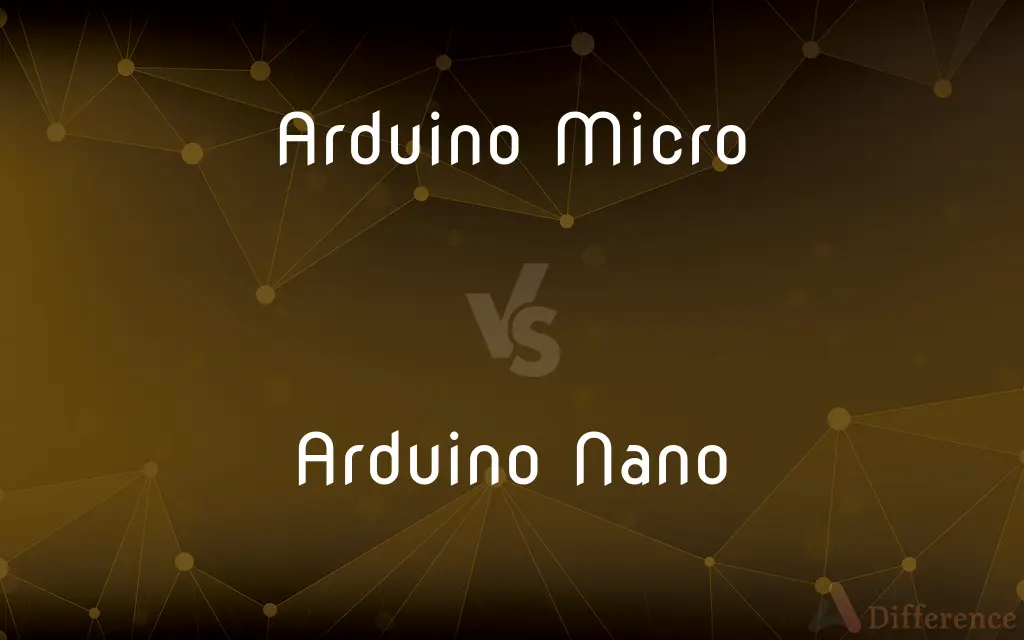Arduino Micro vs. Arduino Nano — What's the Difference?
By Tayyaba Rehman — Published on January 10, 2024
Arduino Micro is a small-sized Arduino board featuring the ATmega32U4, known for its USB functionality. Arduino Nano is a compact Arduino board using the ATmega328, ideal for small-scale projects.

Difference Between Arduino Micro and Arduino Nano
Table of Contents
ADVERTISEMENT
Key Differences
The Arduino Micro is a compact microcontroller board based on the ATmega32U4. It stands out for its built-in USB communication, allowing it to easily emulate a computer mouse or keyboard. This makes it particularly suitable for projects involving human-computer interaction. The Arduino Nano, on the other hand, is based on the ATmega328 microcontroller. It's renowned for its small size, making it perfect for projects where space is a constraint. Both boards are part of the Arduino family, widely used in hobbyist and educational electronics projects.
In terms of physical size, the Arduino Micro is slightly larger than the Nano. This size difference can be a deciding factor depending on the space available in a project. The Micro's larger size is due to its additional features like more digital pins and the native USB interface. The Nano, while smaller, still offers a good number of digital and analog input/output pins for various sensors and actuators.
The Arduino Micro's native USB support allows it to act as a client for a connected computer, enabling direct communication without requiring an additional serial converter. This feature is particularly beneficial for projects that involve mimicking a human interface device. The Nano requires an external chip for USB communication, which slightly increases the complexity for projects requiring direct computer interaction.
Power consumption can also differ between these two boards. The Arduino Micro, with more onboard features, may consume slightly more power compared to the Nano. This consideration is crucial for battery-powered or energy-sensitive applications.
Both boards are programmed using the Arduino IDE and support similar programming libraries and sketches, which makes transitioning from one to the other relatively straightforward for those familiar with the Arduino platform. They are both excellent choices for educational purposes, DIY projects, and prototype development, with the choice largely depending on the specific requirements of the project.
ADVERTISEMENT
Comparison Chart
Microcontroller
ATmega32U4
ATmega328
Size
Slightly larger
Compact and small
USB Interface
Native USB support
Requires external chip for USB
Ideal Use
Human-computer interaction projects
Small-scale, space-sensitive projects
Power Consumption
Slightly higher
Lower, suitable for energy-sensitive applications
Compare with Definitions
Arduino Micro
Arduino Micro is based on the ATmega32U4 with built-in USB.
The designer used Arduino Micro to create a custom game controller.
Arduino Nano
Perfect for small-scale, space-limited applications.
Arduino Nano was chosen for the miniaturized model due to its small footprint.
Arduino Micro
Ideal for projects involving direct computer interaction.
A DIY keyboard was built using the Arduino Micro.
Arduino Nano
Arduino Nano uses the ATmega328 and is known for its compact size.
The student used Arduino Nano for her wearable electronics project.
Arduino Micro
Features more digital pins than the Nano.
Arduino Micro's extra pins were perfect for the complex sensor project.
Arduino Nano
Lacks native USB, requiring an external chip for USB communication.
Arduino Nano was connected to the computer using a serial converter.
Arduino Micro
Slightly larger, accommodating more features.
The robotics project utilized Arduino Micro for its additional connectivity options.
Arduino Nano
Offers a good number of I/O pins despite its size.
Despite its size, Arduino Nano managed to control multiple LEDs in the project.
Arduino Micro
Consumes more power, suitable for larger projects.
The interactive art installation was powered by an Arduino Micro for its robust functionality.
Arduino Nano
Lower power consumption, ideal for battery-powered projects.
A portable environmental sensor was built using Arduino Nano for its energy efficiency.
Common Curiosities
Is Arduino Nano suitable for beginners?
Yes, it's beginner-friendly and widely used in educational projects.
Which board has more digital pins, Micro or Nano?
The Arduino Micro has more digital pins.
What is the main advantage of Arduino Micro?
Its built-in USB support and additional digital pins.
Are both boards compatible with the Arduino IDE?
Yes, both can be programmed using the Arduino IDE.
Do both boards support the same programming libraries?
Generally, yes, they support similar libraries available in the Arduino ecosystem.
Can Arduino Micro mimic computer peripherals?
Yes, thanks to its native USB functionality.
Why choose Arduino Nano for a project?
For its compact size and suitability in small, space-sensitive applications.
Can Arduino Nano be used for wearable technology?
Yes, its small size makes it ideal for wearables.
Is power consumption a concern with Arduino Micro?
It can be for battery-powered projects, as it consumes more power than Nano.
Is Arduino Nano less powerful than Arduino Micro?
Not necessarily in terms of processing power, but it has fewer features.
What kind of USB chip is used with Arduino Nano?
It typically uses an FTDI or CH340G chip for USB communication.
Can Arduino Micro be used without additional components for USB?
Yes, it can be connected directly to a computer via USB.
Are these boards suitable for prototyping?
Absolutely, both are excellent for prototyping a wide range of projects.
Which board should I use for a large-scale project?
Arduino Micro might be more suitable due to its additional features and connectivity options.
Which board is better for a battery-operated project?
The Arduino Nano, due to its lower power consumption.
Share Your Discovery

Previous Comparison
District Collector vs. District Magistrate
Next Comparison
Plants vs. TreesAuthor Spotlight
Written by
Tayyaba RehmanTayyaba Rehman is a distinguished writer, currently serving as a primary contributor to askdifference.com. As a researcher in semantics and etymology, Tayyaba's passion for the complexity of languages and their distinctions has found a perfect home on the platform. Tayyaba delves into the intricacies of language, distinguishing between commonly confused words and phrases, thereby providing clarity for readers worldwide.
















































